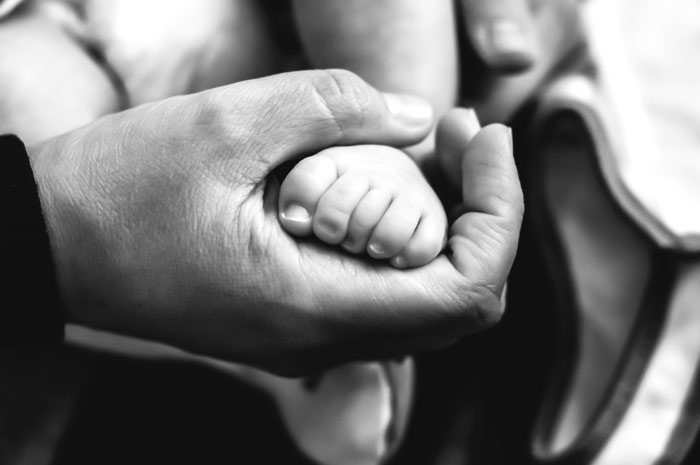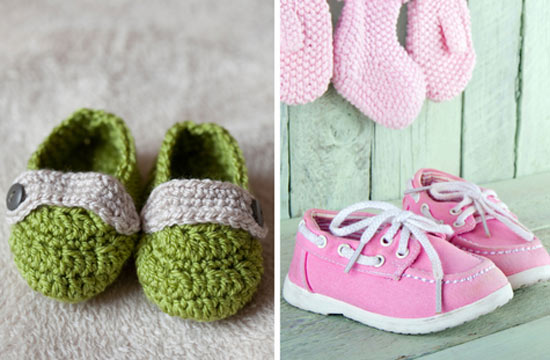Guide to Buying Your Baby’s First Shoes
Choosing the first shoes for a baby, who is not walking yet (and not even trying to!), you can safely be guided by anything: the desire to appeal to your relatives’ and neighbors’ emotional reaction, the desire to spend money uselessly but with pleasure, or just the desire to instill a taste for good shoes in your kid from his/her birth. But as soon as the baby makes the first steps, the requirements for the baby’s shoes are stringent and well-defined.

The baby’s first shoes
The first shoes for the baby should be high-quality and comfortable rather than beautiful and elegant!
When should the baby’s first shoes be bought?
Some pediatricians and podiatrists believe there is no urgent need to buy shoes until the baby makes his/her first steps. Others argue that the baby needs the first shoes already at the time when it is just beginning to stand up on the feet. The time difference between these two achievements is small, so you can buy the first shoes for your child whenever you wish, but not later than the time when your boy or girl is actively trying to walk around the room.
How should the first baby’s shoes look like?
It is up to you to choose what shape the shoes should have. Sandals, shoes, or boots – the first model of shoes depends on the weather outside the window and the area where you are going to walk with the baby. But there should be strict requirements concerning the quality of the baby’s shoes, regardless of the model and the price policy. They are as follows:
- Sandals, shoes, and boots should have a small heel (5-15 mm). This heel is needed not for the sake of beauty or the prevention of flat feet, but in order to eliminate the possibility of the baby’s falling back. The latter, alas, may cause serious head injuries.
- The children’s shoes should have a stiff heel counter, which fixes the heel and will protect the baby from accidental dislocation.
- Inside, there should be a soft removable insole. If necessary, this usual insole can be easily replaced with a special insole with arch support.
- The sole should be flexible and as thin as possible.
- The shoes must match the baby’s foot in size, i.e. the foot should not be loose inside a boot or a sandal. Baby’s shoes can be bought in advance, but it is forbidden to wear them until the right time comes.
- Baby’s shoes should not be pointed or narrowed (like boat shoes). For the baby’s foot to grow and develop properly, it is necessary that the baby should freely wiggle all the toes inside the shoe.

A photo on the left illustrates a not very good choice of outdoor shoes, whereas on the right you can see the good choice of footwear. Baby’s shoes should be warm (if it is cold outdoors) and reliably fix the foot that is still immature, protecting the baby from sprains.
Should the baby be bought orthopedic shoes?
Nowadays, one can often hear a proud statement from young mothers that they buy special orthopedic shoes for the kid for the purpose of preventing flat feet and helping them develop correctly… In fact, this situation is an absurd case of self-deception. Any practitioner will tell you that orthopedic shoes are only for sick people, not for healthy ones.
Mothers are often sold the most common baby’s shoes under the name of orthopedic footwear. In most cases, these shoes meet all the requirements (made of leather, broad enough, with a rigid heel, etc.) and have special insoles that really help in the prevention of flat feet in children (this issue will be discussed below).
How to choose the baby’s first shoes
Buying children’s footwear, especially for making the first steps, you can trust online stores only in one case – if the model that you choose online has already been tested and approved in real life. In all other cases, especially when choosing a new model and a new size, you have to go to a conventional store and have a close look at every pair of shoes.
Trying the patience of the future owner of the shoes is not needed. The baby is still unable to assess the usability of shoes and their size. Taking the baby with you when purchasing shoes is not necessarily.
Draw the baby’s foot contours on thick cardboard (go round the contour and then carefully cut it with a margin of about 1-2 mm). This pattern will help in selecting shoes in a much more effective way than the baby. Collect the models that you like for aesthetic reasons and then check them for compliance with the requirements. After that, use the cardboard template of your baby’s foot to select the right size.
Of course, every toddler has a different shoe size (like everything else) and is growing in a very individual way. But there is a general observation: up to two years, the average baby’s foot grows by 1-1.5 size every 3 months.
How many pairs of shoes does your baby need?
For street walking, the baby who has just started walking will need one pair of shoes.
But in addition to walking outdoors, babies should wear something in the house. Beautiful indoor booties – knitted or stitched of various fabrics – are suitable for the babies who are not walking yet, but are on the point of doing that. If the baby easily rises to its feet and makes the first steps in the house – plain “street” sandals or shoes “according to all the rules” would be fine for wearing indoors. These shoes must necessarily have a heel, arch support and a rigid heel counter; it is desirable that they should be of natural leather, matching the foot size perfectly well.
As soon as your baby begins to learn how to walk – it’s time to throw away all the knitted booties and denim slippers and replace them with sandals or leather shoes with a stiff heel. The baby will step on the feet more confidently and without the risk of spraining an ankle.
Can incorrectly selected baby shoes cause flat feet?
When doctors announce to parents that their children develop flat feet, 95% of them instantly put the blame on themselves – many medical surveys show that the majority of parents believe the flatfoot disorder arises in their children on the background of wearing incorrect shoes. In fact, this opinion is wrong.
The development of flatfoot is affected by the baby’s way of life rather than by the shoes. Flat feet and shoes do not have any connection. However, in rare cases some forms of flat feet can sometimes be fixed by wearing special orthopedic shoes. But if your foot is healthy – it is almost impossible to make it “flatfooted” using any shoes.
A few words about flat feet. All newborn babies have perfectly even soles – they are a perfect example of flatfoot! But over time the baby’s foot begins to form a certain bending (the so-called arch of the foot), this process is particularly intense when the baby makes its first steps. This bending in the feet is necessary when jumping, running, or falling from a height – to protect the spine, the pelvis and knee joints.
The right foot bending is influenced by a certain group of muscles that are naturally reduced, when a baby walks on an uneven ground – land, grass, sand, etc. Deviation from the norm includes not only flat feet, but on the contrary – a too high arch of the foot.

- 1 – normally shaped arch of the foot;
- 2 – too high rise of the foot;
- 3 – flat foot.
All three situations “are seen” from a trail – dip the baby’s foot in gouache, and then let the baby stand on a sheet of paper: you will immediately see how developed or not the arch of the foot is.
As modern children often have to deal with flat surfaces (asphalt, parquet, laminate, linoleum), parents still have a few ways to compensate for the deficit of “naturally uneven places”, which are so useful for the prevention of flatfoot in kids and forming a reliable arch of the foot:
The kid should take every opportunity to be placed on an uneven surface – sand or pebbles on the beach, grass on the lawn, children’s ‘climbing frame’ and slides, etc.
Uneven surfaces can be arranged at home – fill a big cloth bag or, for example, a large pillowcase with whole nuts (hazelnuts or chestnuts would be ideal), and stimulate the baby to just spend time on this bag – at least 50-60 minutes a day. With the same purpose, you can buy a special orthopedic pad.
Buy the first shoes for your baby with a slight arch support (a special insert in the shoes, which helps create the right arch of the foot).
Strictly speaking, it is not quite correct to talk about the baby’s flat feet if the baby is under one year old. From the medical point of view, such a thing as baby flat foot problem (and especially in infants!) does not exist.
The arch of the foot is formed completely and utterly in boys and girls by the age of 12 years. Until it is finally formed, any position of the foot should be absolutely fixable and physiological. That is why the term “infant or baby’s flat foot” is a somewhat absurd diagnosis because all babies are born with flat soles of the feet. And with time, the foot changes its arch in some children up to the age of 12 years.
We have already mentioned that the development of flat feet is not influenced by shoes. A huge negative role in the formation of a flat sole (with the absence of the arch) is played by a sedentary lifestyle. The arch is formed and strengthened, it is necessary that the muscles of the foot work actively. To do this, make sure that the baby moves a lot during the day, especially on uneven surfaces. Pay attention to slides in the yard, sand and pebble beach, etc.
Remember that the diagnosis of “flat” feet is voiced by orthopedists to 95% of all kids under the age of 2 years. However, they often forget to add that this flat foot is a completely normal (physiological) phenomenon – in fact, the baby’s foot is just beginning to take shape. … If your child moves actively, this childish flat foot will disappear by itself (you will not even notice this!).
How should the first baby’s shoes look like: a summary
The quality of baby’s shoes – especially the shoes “for the first step” – does not depend on their cost, looking “beautiful”, or the popularity of the brand. Alas, sometimes the most well-known brands produce very “ugly” shoes in terms of the baby’s health.
Thus, neither the price nor the famous brand or luxurious exterior design can be a sign of high-quality baby shoes. To choose safe and truly useful footwear for your toddler, you have to consider a lot of children’s sandals, boots and shoes. Take and twist them, study the insoles, heels and toes, ask if you can check whether the material is natural. This is the only way you can choose the perfect first shoes for your baby. However, three months later the search will begin again…
